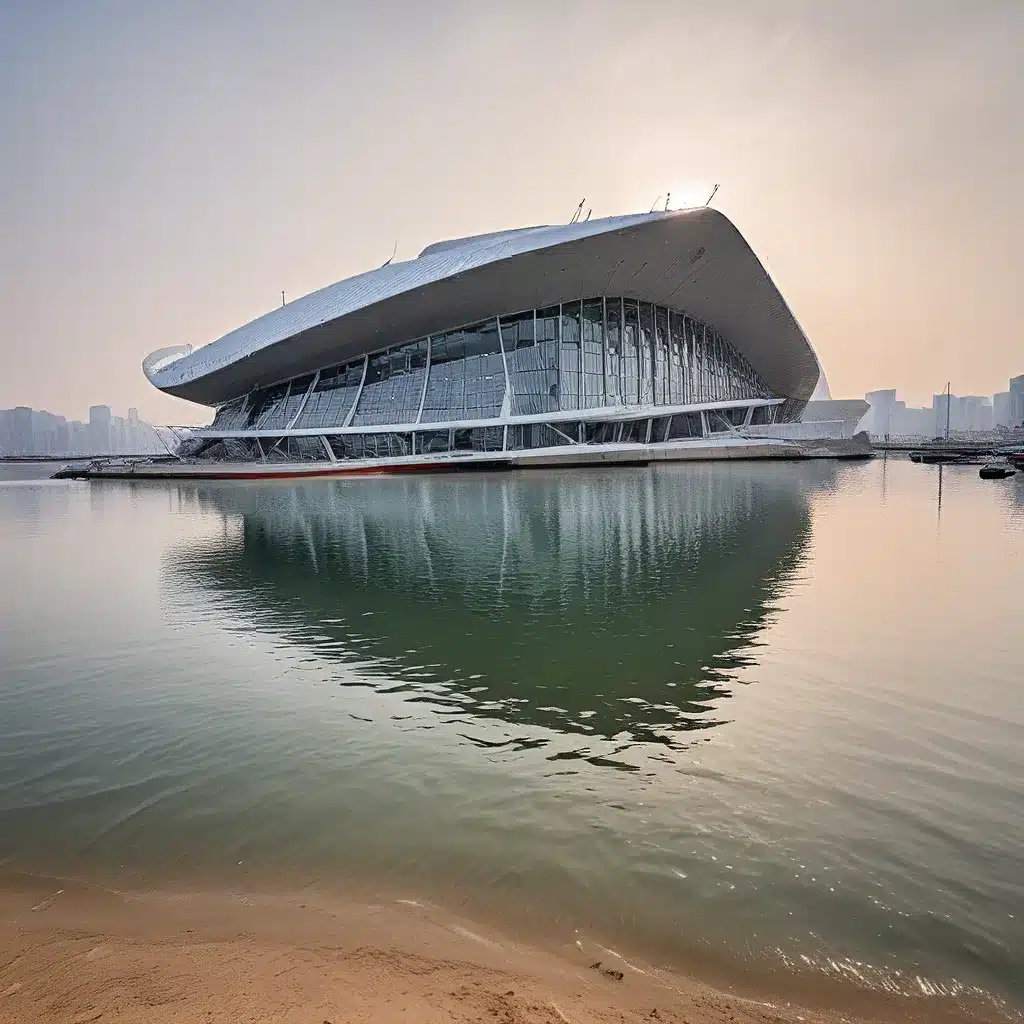
Nestled along the stunning coastline of Shandong Province in eastern China, the Qingdao Olympic Sailing Center stands as a testament to the harmonious integration of sport, architecture, and the natural environment. This state-of-the-art facility, which served as the primary venue for sailing events during the 2008 Beijing Olympics, has since become a global symbol of the country’s commitment to sustainable infrastructure development and the promotion of Olympic values.
Architectural Brilliance and Environmental Harmony
The Qingdao Olympic Sailing Center was designed by the renowned architectural firm, CCDI Group, with the primary goal of creating a venue that would seamlessly blend with the breathtaking coastal landscape. The architects’ meticulously crafted design incorporated a range of sustainable features, including the use of renewable energy sources, efficient water management systems, and environmentally-conscious building materials.
One of the most striking aspects of the center’s architecture is the striking, sail-inspired roofline that dominates the skyline. This innovative design not only pays homage to the sport of sailing but also serves as a practical solution to the region’s challenging environmental conditions. The curved roof efficiently harnesses the powerful coastal winds, helping to naturally ventilate the indoor facilities and reduce the center’s overall energy consumption.
The integration of the natural landscape is equally impressive. The gently sloping terrain and carefully curated gardens and green spaces create a seamless transition between the built environment and the surrounding seaside vistas. This harmonious blend of architecture and nature has earned the Qingdao Olympic Sailing Center widespread acclaim for its outstanding design and environmental sensitivity.
Technological Innovations and Sustainable Infrastructure
Beyond its breathtaking aesthetics, the Qingdao Olympic Sailing Center is also a technological marvel, incorporating a host of innovative systems to enhance the visitor experience and minimize its environmental impact.
One of the center’s most notable features is its advanced wind and wave monitoring system, which uses a network of sensors to continuously track and analyze the ever-changing coastal conditions. This data is then used to optimize the venue’s operations, ensuring that sailing events can be held safely and efficiently, even in the face of unpredictable weather patterns.
In addition to its cutting-edge technology, the center also boasts a comprehensive sustainable infrastructure that includes solar photovoltaic panels, rainwater harvesting systems, and high-efficiency building materials. These features not only reduce the venue’s carbon footprint but also serve as a model for sustainable development in the region.
Embracing the Olympic Spirit
The Qingdao Olympic Sailing Center’s commitment to sustainability and environmental harmony extends far beyond its physical infrastructure. The venue has also become a hub for the promotion of Olympic values, hosting a variety of educational programs and community outreach initiatives.
According to the International Council of Sport Science and Physical Education (ICSSPE), the Olympic values of excellence, friendship, and respect are at the core of the center’s mission. Through its interactive exhibits, workshops, and sports clinics, the venue inspires visitors to embrace these values and strive for personal and collective growth.
Moreover, the center’s strong ties to the local community have helped to foster a sense of pride and ownership among Qingdao’s residents. Residents and visitors alike can take part in a variety of recreational activities, from sailing lessons to coastal cleanup initiatives, all of which contribute to the venue’s role as a hub for sustainable development and community engagement.
A Lasting Legacy
As the legacy of the 2008 Beijing Olympics continues to unfold, the Qingdao Olympic Sailing Center stands as a shining example of how sports infrastructure can be designed and utilized to promote environmental stewardship, technological innovation, and community engagement.
According to the United Cities and Local Governments Asia-Pacific (UCLG ASPAC), the center’s success has inspired similar sustainable development projects across China and beyond, as the country continues to leverage the power of sports to drive positive social and environmental change.
Indeed, the Qingdao Olympic Sailing Center stands as a shining beacon of what can be achieved when environmental sustainability, technological innovation, and community engagement are seamlessly integrated into the design and operation of a world-class sports facility. As the global community continues to grapple with the challenges of climate change and sustainable development, this remarkable venue offers a powerful model for the future of sports infrastructure and the promotion of Olympic ideals.
Ongoing Research and Evolving Perspectives
While the Qingdao Olympic Sailing Center has undoubtedly achieved remarkable success, there is ongoing research and debate surrounding the long-term impacts of such sustainable sports infrastructure projects.
According to a recent study published in the MDPI Sustainability journal, some experts have raised concerns about the scalability and replicability of the center’s innovative design and technology. They suggest that further research is needed to fully understand the economic, social, and environmental implications of such large-scale investments in sports-related sustainability initiatives.
Nevertheless, the Qingdao Olympic Sailing Center remains a shining example of what can be achieved when visionary thinking, environmental stewardship, and community engagement are prioritized in the development of sports infrastructure. As the global community continues to explore new frontiers in sustainable development, this remarkable venue serves as a testament to the transformative power of sports to drive positive change and inspire future generations.

